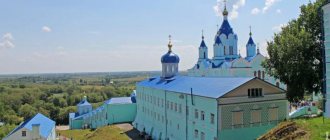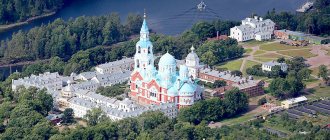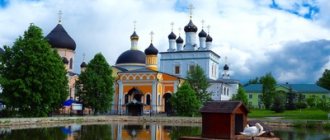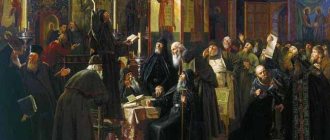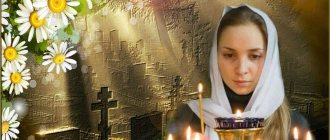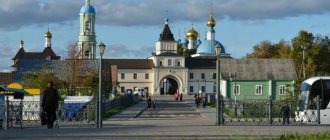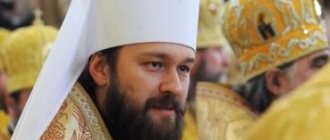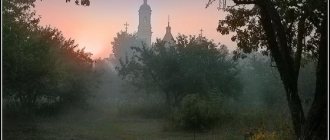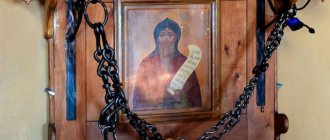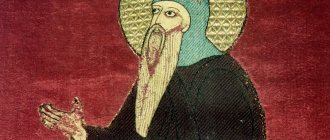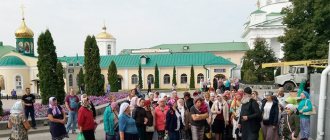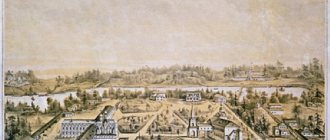History of the monastery from the beginning of its foundation
According to legend, in 1295 there were dense impenetrable forests in this place. Two hunters, following the trail of the beast, came across a strange board, and turning it over, they discovered an icon.
And then a source of spring water came out of the ground. The hunters, deciding that this was a real sign of the wonderful properties of this place, left a sign there. Later they spread the news about the diva to all people.
It is important to know:
After several years, a wooden chapel was built on that very spot.
The construction of the monastery itself came at a difficult time. During that historical period, Muscovite Rus' was subject to attack by the Crimean Tatars. Construction proceeded very slowly, because difficult conditions and lack of funding made it difficult to advance construction. However, the building was rebuilt; the founding date of the monastery is considered to be 1597.
After the death of Ivan the Terrible, there was no heir left. A time of troubles has arrived. Many contenders for the throne appeared, one of whom, False Dmitry, seized power in the country and personally installed himself on the throne. By his order, the main miraculous icon of the Mother of God was given to Moscow.
False Dmitry
There she stayed until the very end of the difficult time of troubles for Russia. The icon returned to its place only in 1618. This event became one of the turning points in history. It was marked by the opening of a new church, which was given the name “Nativity of the Blessed Virgin Mary.”
In 1634, not the best time came for Russia again; the monastery again had to endure severe hardships. After the attack on Kursk by the Poles, the monastery was devastated. And already in 1643 there was a new raid on the city by the Crimean Tatars. However, despite the difficulties, the Kursk Hermitage managed to survive.
Only in 1701 this place was officially given the title of monastery, and a hostel for monks was opened. In addition, many other buildings were reconstructed. Two years later it came to the Nativity of the Theotokos Church. The old wooden building was replaced by a magnificent white stone building with two floors.
The important thing is that the building has survived to this day.
Seven years later, in 1708, it was decided to continue construction work. The most beautiful holy gates and a church with several altars were erected. One was given the name Transfiguration of the Lord, and the second was dedicated to the Archangel Michael. In 1713, the “Picturesque Spring” church was founded.
A new era in construction opened in 1860, when construction began on the magnificent cathedral, which was named the Nativity of the Blessed Virgin Mary. However, very soon the white streak in the life of Kursk Abbey and its inhabitants ended. The difficult years of the Soviet period were coming.
After the onset of Soviet power and the overthrow of Emperor Nicholas II, a difficult time came for the Orthodox Church in Rus'. It marked the destruction of all the principles and ideals of the faith, everything sacred that was in churches and cathedrals.
Most of them were plundered and destroyed or converted into civilian objects. The Root Desert did not escape this fate, for which the most difficult time in its entire existence had come.
Already in 1918, it was renamed “Svoboda Shtetl,” and the holy monastery lost its right to officially represent the Orthodox Church, losing its legal force. In 1922, all valuables and shrines were removed from the monastery according to a special program developed by the All-Russian Central Executive Committee.
Despite this, some devoted people remained huddled in dugouts nearby, whiling away their days in prayer. Many buildings were destroyed brick by brick, including two tiers of the bell tower; the unique library was taken away along with holy icons and other valuables. The area adjacent to the monastery has also changed.
The unique Bogoroditskaya grove with relict oak forests was cut down, crops with medicinal herbs were destroyed. Later, a fountain was built on the site where the cathedral stood, and the Freedom camp was opened in the monastery building itself. During the war, many buildings were destroyed, and in those that remained intact, a vocational school was organized in 1947.
After all the hardships, only in 1989 they began a program to restore the holy, desecrated place. Through the enormous efforts of the Diocese of Kursk and Archbishop Juvenal, the legal significance of the monastery was returned to the Kursk Hermitage, and the land came under the authority of the Orthodox Church. Only in 1990 was the restoration completed. In honor of this solemn event, a religious procession was organized. It was the first in many decades of Soviet power.
Fools of old Kursk
For a long time in Rus' there were people who took upon themselves a special form of ascetic service to God and their neighbors - foolishness (for Christ's sake). Some of them actually suffered from mental and mental disorders, others deliberately took on the appearance of madness. Having lost their minds or renounced them, as well as leading an ascetic life, they received the supernatural gift of divination and great veneration among the people. The holy fools are well known: St. Basil the Blessed (XVI century), Xenia of Petersburg (XVIII century), Ivan Koreysha (XIX century) and others. As for Kursk, our city was no exception in this regard. Information about these amazing people has been preserved in rare sources and legends that have come down to us.
Perhaps the earliest mention of them comes from the life of St. Seraphim of Sarov, describing the actual “Kursk” period in the life of the future great elder. From it we learn that in the second half of the 18th century there lived a man in Kursk (his name is unknown) who took upon himself foolishness as a feat of saving his soul. Many people knew him in the city, including Prokhor Moshnin. It was under the influence of conversations with this extraordinary personality that the boy’s idea of monastic life matured...
In the 19th century, foolishness also took place. One of those who took on this difficult burden was the elder of the Kursk Holy Trinity Convent Evdokia Alekseevna Rastorgueva (1790-1870). Even at a young age, she told her parents, who were baking bread in Kursk, about her intention to enter a monastery. But her parents were against this decision and wanted to marry her off. Then Evdokia took upon herself the feat of foolishness. When she was forced to dress in her best dress and go to the groom's bride, she, not fulfilling her mother's will, took a prune berry and, having removed the seed from it, put it on her nose. Another time she stained her head with crushed hemp, and then cut her hair completely. Ultimately, the parents yielded to the will of their daughter and she entered the monastery.
Evdokia settled in the north-eastern corner tower of the monastery fence. She never heated her home, although firewood with offerings from admirers lay right there on the floor. Her clothes in winter and summer consisted of one cassock. She spent her nights almost sleepless in singing psalms and fervent prayer, and during the day she left the monastery for the city, stopping nowhere except in every church where she prayed. She carried a wooden dish with a cross and stones in it. She never parted with him.
Many came to the blessed one and, despite the sometimes unfriendly treatment, they deeply revered and believed in the power of her prayers. Sometimes she threw a log and shouted to those who came: “Here is a storm, here is the wind, why are you coming to me? What do you need?". And this meant that in the near future something bad awaited those who came to her. She received others kindly and even gave them tea, which was a good sign.
One day, a rich honorary citizen who revered her came to her. Evdokia Alekseevna sat her down on a thin chair. “Why are you putting me on a bad chair, mother! Does this mean anything bad? she asked. “No, no, sit down, it’s nothing, but what I read was that one was rich and noble, he lived luxuriously, and then he ended up in prison and all his wealth was gone,” answered the old woman. “Is it true that you are talking to me, mother?” - asked the visitor. “No, no,” said the blessed one, “I read that.” Soon, the husband of this honorary citizen was sentenced to 12 years in prison for giving a minor as a soldier for his brother.
Another time, a relative of a nun came to the old lady, who had heard a lot about Evdokia Alekseevna’s foresight. “Ah, the St. Petersburg gentleman has arrived,” she greeted him, “sit down, sit down.” But there was nowhere to sit: the blessed one sat down on a bench; there was no chair, and, ceasing to pay attention to the guest, she hung her head low, as if falling asleep. After standing for a short time and seeing that the blessed one seemed to be sleeping, he left. He expressed displeasure to his relative, saying: “What a perspicacious woman is this, she fell asleep!” Returning to the capital, he rode in a carriage. However, the “dream” of the blessed one turned out to be an eternal dream for this man: the horses carried him so wildly that he jumped out of the carriage in fright and fell to his death.
When Evdokia Alekseevna died, for 4 days her body was not touched by decay and she lay as if alive. She was buried at the Nikitsky cemetery. Admirers erected a monument at the grave and surrounded it with bars. This burial has not survived to this day. Another very famous holy fool in Kursk and beyond was Elder Alexander Ivanovich Sadovsky (1822-1893). He came from the nobility of Oboyansky district and in his youth served in the Bug Ulan regiment. Having retired as a lieutenant in 1850, with a small pension (81 rubles per year), he lived for about 12 years in the Staro-Oskol district, and then moved to Kursk. Here, being single, he lived until his death, gaining particular fame for his foresight.
In moments of difficult trials or before starting any business, many Kursk residents considered it their duty to turn to him for advice. To a large extent, what he predicted came true. A.I. Sadovsky was not afraid, with directness and strength of character, with love for truth and goodness, to expose vices and give instructions to those who turned to him. He acted on the hearts of those who came with a simple allergic, but strong edification. Some received satisfactory answers from him, others received instructions, and others received an edifying and severe reprimand. He tried to instill in everyone a lack of acquisition of earthly blessings, humility and constant love for God and neighbor. For clarity, the elder defiantly trampled gold with his feet, for which purpose a rug made of gold coins lay next to his bed.
One day, in order to play a prank, a group of tipsy students showed up to Alexander Ivanovich. Going to the elder, they reported that one of their comrades, who was at home, was supposedly sick and asked to pray for him. To this the seer answered: “Okay, I’ll pray... Only now for the peace.” Returning to their apartment, the cheerful company found their friend dead. Another time, for the same purpose - to play a prank, high school students came to A.I. Sadovsky. At the same time, he put a spoonful of sugar into a glass of tea. Seeing the newly arrived guests, the elder immediately understood the intent of their visit and said: “Have you come to chat?.. Well, chat!”, and handed them a glass with a spoon.
Before his death, he went to the all-night vigil at the convent and, saying goodbye to the parishioners, as well as to the nuns, said: “Farewell, Orthodox; forgive me old man.” At the same time, he bowed very low. Then, sitting opposite the usual in a cab sleigh, he went home to an apartment in Istomina’s house on Arkhangelskaya Street (K. Liebknecht, 27). The next morning the elder died. The news of his death quickly spread throughout the city. The masses of people hurried to the deathbed to say goodbye to the deceased and pay him their last debt. Arkhangelskaya Street was an unprecedented bustle the entire time the body of the deceased was in the apartment.
A.I. Sadovsky was buried in the church fence of the All Saints Church at the Kherson cemetery. Requiem services were often held at his grave, and admirers took soil from his burial. It was preserved until the early 1990s, when construction of the southern aisle of the church began, with the construction of which the grave disappeared.
...Alas, the crushing twentieth century actually caused the disappearance of this unusual method of saving the soul in the forms it was before. It is painfully difficult in modern society to imagine personalities of the past who would be able to survive in this world and selflessly serve people who, no matter what, would retain a good memory of them. “Kursk Diocesan Gazette”, N 4 for 2005
Current state of the monastery
Thanks to the restoration work carried out, many buildings were created anew. They were restored from ruins.
Keep in mind:
Many cultural values of the Russian Orthodox faith were returned to their ancestral land.
The consecration of the Root Hermitage was carried out in 1991 by Patriarch Alexy II in honor of the opening of the newly built Church of the Nativity of the Blessed Virgin Mary. Only in 2004 a meeting of the patriarchs was organized, at which a decision was made to resume the operation of the monastery.
To bring this great cause to life, a huge amount of money and effort was made. The Bishop's Hotel, where the guests of the monks were located, was revived.
The beautiful painting of the holy gates was created from scratch. The Abbot's building was rebuilt, the main Cathedral underwent a complete reconstruction.
Gate of the Root Desert
In addition, significant work was carried out on the arrangement of the entire territory of the monastery, including the Temple of the Life-Giving Spring. Only in 2012 the restoration work was completely completed. In honor of this memorable event, the Liturgy was served and the rite of consecration was performed.
Take note:
In this monastery, lectures are carried out, conducted by Father Nikita. These are special prayer rules that are performed over demon-possessed people. For the sake of idle curiosity, you should not attend these prayer services. All sufferers and their relatives must take a blessing from the priests to attend the readings.
The monastery of Seraphim of Sarov receives for special prayers for the sick - deductions - all who suffer from spiritual and physical infirmities, and desire, by the grace of God, to get rid of them.
Thus, the temples, the monastic monastery and the surrounding area were completely revived and restored, and all the premises were landscaped. Today there are four cathedrals in the monastery. All of them are in working order, despite this, on normal days services are conducted in only one. This is the Cathedral of the Nativity of the Blessed Virgin Mary. On holidays, Liturgies are celebrated in other churches.
Activities of the parish
There is a Sunday school at the church. It teaches children the basics of the Orthodox faith, church history, introduces them to the Church Slavonic language, and helps them find friends among believers. They are gradually introduced to the course of the services so that the little parishioners can understand everything that is happening in the church, and they can consciously be present in it and pray together with everyone.
Interesting! Along with the Sunday school, the Orthodox youth club “Seraphim” operates at the church. Its opening took place on December 13, 2021. The founders of the club were Archpriest Georgy Annenkov, the rector of the church, and Deacon Alexander Polyakov, who took over the responsibilities of the leader, as well as Orthodox young people.
Meetings of club members are held on Wednesdays at 19-00 in the Sunday school premises. At them, young people become more deeply acquainted with the Orthodox faith, get to know each other better and communicate, raise interesting topics for discussion, plan pilgrimage trips, and so on.
Description and architectural features
All existing churches of the Root Nativity of the Blessed Virgin Mary of the Desert were built in the classical Russian style. White stone walls are decorated with golden domes on the towers and chapels.
Some buildings were erected quite recently. In their place there used to be wooden churches, and later simple stone buildings destroyed during the Soviet period. Thus, the Temple of the Icon of the Mother of God “Life-Giving Spring” was consecrated only in 2012 by Patriarch Alexy II.
The blue roofs of the building perfectly set off the golden domes. The interior decoration itself is made in the Byzantine style.
Here you can see a beautiful decoration of frescoes and icons, many holy objects that were returned to their homeland after the revolution.
The beautiful architectural ensemble of the monastery, painted in a heavenly color, looks wonderful from anywhere in the city, especially from the banks of the Tuskar River.
Shrines of the Nativity of the Virgin Mary Hermitage
One of the main shrines of this wonderful place is the “Sign” icon. It was this that hunters found in this place a long time ago, after which a temple was created here, and then a desert. The icon repeatedly showed miracles to the world and streamed myrrh, so it was almost immediately ranked among the miraculous.
Icon "The Sign"
Also here are the holy relics of the venerable Kiev-Pechersk and Optina elders.
Thousands of pilgrims flock here to touch the holy remains.
Story
In the city of Kursk and the surrounding region there are many places associated with the life of Prokhor Moshnin, who later became famous as Elder Seraphim of Sarov. Here, in the center of the nightingale region, his ancestors lived, he was born (1754), spent part of his life, and he himself. Therefore, the city and its surroundings attract many tourists and pilgrims who want to visit places that preserve the memory and silent testimonies of the saint.
Icon of St. Seraphim of Sarov
The temple, built in honor of the famous city dweller, is located on Polevaya Street 17. According to legend, it stands on the very spot where gypsies once settled. Vagrants were not allowed into the city and, to escape the spring floods, they built their tents on a hillock. Gypsies had different types of professions. Some were engaged in repurchasing horses and cattle, others were farriers and songwriters. This is where the name of this area comes from.
The stone brick building of the two-complex theological school and the Church of Seraphim of Sarov attached to it was erected in 1905 through the efforts of the merchant I.V. Puzanov, who donated ten thousand rubles to the city budget for these purposes. This is the last stone church built before the October Revolution. The temple was consecrated by Bishop Pitirim, the ruling bishop of the Kursk province at that time.
From the first days, the temple began to attract crowds of pilgrims seeking the help and intercession of Saint Seraphim. Believers from all over the city came here. At that time the church was not yet a parish church. Divine services were conducted there by a visiting clergyman from the cathedral (Znamensky).
Ivan Vasilyevich Puzanov in his spiritual will vaguely stated the status of the temple that he wished to build. He wrote that it would be a church at the school. But the question arose, how to understand these words? Either he wanted to make a house church for the city school, or he wanted to show the location that it was located not far from the school. And for 10 years after its construction, the temple was listed as a church-school according to documents.
Church of St. Seraphim of Sarov in Kursk
Following persistent petitions submitted to the city government by Bishop Pitirim, and then by Kursk Archbishop Tikhon, the church and the school attached to it were transferred to the jurisdiction of the diocesan authorities only in 1915. The church became a parish, and the separated school began to be called “Puzanovskaya” in honor of the merchant-philanthropist.
The community of believers existed here until the thirties of the last century. During Soviet times, the church was used for other purposes. The premises were given to the nearby secondary school No. 12. Celebrations and assemblies and sports activities were held here. Workshops, a gym, and classrooms were located on the territory of the temple. A similar fate befell many churches in Russia at that difficult time.
River Tuskar and holy springs
The monastery is located near the Tuskar River. Many sources flow from it. Several of them can be considered saints. For example:
- Source of the Great Martyr Pantelemon;
- Source of Seraphim of Sarov;
- Source of St. Nicholas the Wonderworker;
- Source of the “Kazan” Icon of the Mother of God.
Thus, you will be able to touch holy water in several places at once and wander through the wonderful picturesque places on the territory of the monastery. To get to the very place where the main shrine was found - the “Sign” icon, because it was from that very place, according to legend, that the source began to flow.
Information for pilgrims and tourists
The following information will be useful to those who decide to make a pilgrimage or to the Root Men’s Hermitage:
How to get there
There are several ways to get to the holy monastery. The simplest and most convenient: from the city of Kursk at the railway station, take a minibus that departs from the Dubrovinskoye stop. Here, every twenty minutes, gazelles begin their route and make their way to the village of Svoboda. The distance from Kursk to Svoboda metro station is 33 km, travel time is approximately 35 minutes;
Where to stay
On the territory of the monastery there are several hotels for tourists and pilgrims. This is hotel No. 1 “White” and No. 2 “Red”. At the same time, guests are accepted only at the Krasnaya Hotel, since the first one is for church ministers and monks.
Cost of living for one person:
- Single 400 rub.;
- Multi-seat 200 rub.;
- Triple 250 rub.;
- Double 300 rub.
The hotel has been recently renovated and is in good condition, has all the necessary amenities, is clean and bright, with beautiful views of the surrounding landscape of the monastery;
Excursions
On the territory of the Root Desert, free excursions around the temple complex and the surrounding area are held for everyone. The abbot will tell you about the history of the monastery, its difficult fate, and restoration work to restore the main architectural ensembles. It will also show the location of the holy springs and shrines of this place. If you wish, you can make a donation to the needs of the monastery;
If you ever have to go on a long business trip to the Kursk region, do not be discouraged: treat your forced exile as a pleasant trip. Unexpected adventures await a passenger who boards a Kursk tram or commuter bus. Which, perhaps, will help you understand why large inscriptions hang in the central city cafes: “Kursk is the best city in the world.”
The villages of the Kursk region differ little from those in Voronezh: the same roads, the same dull private sector. The exception is, perhaps, the village of Svoboda. on the territory of which there is a favorite place of all Orthodox pilgrims, known as the Kursk Root Hermitage. Just half an hour’s drive from Kursk and you’re there.
You can stay overnight in this building and at the inn, next to which there are cafes, restaurants, a fair and even a store that sells food for cats and dogs. The infrastructure of the village can only be envied.
What is Kornaya Pustyn known for? A men's monastery, which was completely destroyed during the years of Soviet power, and then rebuilt, with springs with holy water and the famous icon, better known as the “Sign” of the Mother of God. You can learn about the centuries-old history of the monastery in the historical and cultural center located next to the monastery. There you will see rare archival photographs of Marshal Konstantin Rokossovsky, read letters from Prince Sheremetyev and military leader Kutuzov, who venerated the shrine: for a long time the icon was the patroness of the Russian army.
Travel icon
Root Hermitage is called because of the miraculous “Sign” icon of the Mother of God that appeared here in 1295 at the roots of an elm tree, since ancient times called Kursk. With the appearance of the wooden icon, a water source began to flow. Over time, the fame of the miraculous icon reached Moscow. Tsar Fyodor Ioannovich ordered it to be moved to Moscow for worship. And later he issued a decree in which he ordered to build a monastery of the Nativity of the Virgin Mary in the place where the icon appeared. The icon itself remained in the capital until the end of the “time of troubles” and until Mikhail Fedorovich Romanov came to the throne in 1613.
This miraculous icon existed until 1597
At numerous requests from the Kursk residents, he ordered the icon to be moved back to Kursk. But before “departing,” he ordered the shrine to be decorated with a gold frame studded with pearls and precious stones. The icon was carried from Moscow to Kursk in a religious procession. Since then, the Znamensky Monastery has become the permanent “place of residence” of the icon.
"Classic" list of icons
The icon itself was blown up: on March 8, 1898, in the Znamensky Cathedral of Kursk, revolutionary terrorists planted a bomb on the image of the Mother of God. As a result of the explosion, a massive wall cracked, the cast-iron canopy above the icon was destroyed, nothing remained even of the marble steps, and the glass in the cathedral cracked. But the miraculous icon remained safe and sound - they say that even the glass in the icon case was not damaged.
Later list of icons
In 1919, with the outbreak of the Civil War, the icon was evacuated to Serbia. In Belgrade in 1925, the Russian Trinity Church was built for her. from that time on, the Kursk Icon of the Sign became the main shrine of the Russian Diaspora. In 1944, along with the emigration, the icon began to travel around Europe - the shrine visited Vienna, Munich, Paris, London, Brussels. The icon’s adventures ended in the USA, not far from New York, where the “emigrant” arrived in 1951. Now it can be seen in the New York Synodal Cathedral of the Sign of the Mother of God.
Closed springs
The Kursk Root Hermitage itself is located near the Tuskari River. The hill on which the monastery stands offers a picturesque view. In October 1923, Pustyn was closed, and the monastic brethren took refuge in dugouts, enduring hunger and cold. Monastery valuables, including a unique library, were looted. The monastery's temples, the bell tower, the steps leading to the source, and the historical chapel at the root where the icon was found were dismantled brick by brick. On the site of the Church of the Nativity of the Virgin Mary, the Svoboda sanatorium was built. After the Great Patriotic War, a vocational school was located in the surviving monastery buildings, which later became an agricultural vocational school.
Numerous pilgrims come here not only to draw holy water from the springs, but also to pray to St. Seraphim of Sarov, whose sculpture stands on the territory of the monastery. In 1959, Kursk communists from the executive committee of the Svobodinsky District Council of Workers' Deputies issued a decree that prohibited public access to the springs of the Root Desert.
“...the organizers of the pilgrimage to the spring in the former “Root Hermitage” are various kinds of cliques, fools and other dubious persons who use the spring to spread superstitions and extract large sums of money from the population. By gathering at the springs, people, who also swim in the shallow river (Tuscari - author's note) and use these springs, turn them and the surrounding area into a hotbed of infection. This creates a high infectious morbidity rate in the area...”
said in the leaflets announcing the order of the authorities.
The Kursk Root Hermitage was rehabilitated in 1989, that is, after 66 years of an atheistic ban. Since then the monastery has been revived. In 1991, Patriarch Alexy II of Moscow and All Rus' visited the Root Hermitage and consecrated the first revived church in the former refectory building.
Where is:
Svoboda town, Zolotukhinsky district - 30 km from Kursk.
This is the first thing that comes to the mind of every Kursk resident. The Kursk Root Icon of the Sign of the Mother of God was found here. Let us remind you that it was discovered by hunters in the roots of a tree on the banks of Tuscari. As soon as they lifted the image from the ground, a source began to flow in this place.
One of the legends speaks of a detachment of Tatars who attacked the chapel where the icon was kept. The holy image was cut into two parts with a saber. However, after some time, the fragments grew together by themselves.
Another of the miracles was the salvation of Prokhor Moshnin (the future Venerable Seraphim of Sarov) from a fatal illness. During the religious procession, a heavy downpour began, and the procession turned into the Moshnins’ courtyard. The child was placed next to the miraculous icon, after which he began to recover.
On the territory of the Root Desert there are more than sixteen holy springs that heal from various ailments. Everyone flows into the river, the waters of which, flowing through protected areas, are also considered healing. Taking a plunge into icy water is not easy even in summer. The first moments are breathtaking. But what a wonderful feeling comes when leaving the bath! It’s like being born again.
Patronal holidays
Revered by Orthodox believers during his lifetime, St. Seraphim of Sarov became one of the most beloved saints of the Russian people. Soon after his death, the first life of the saint was compiled, and miracles of healing were performed at his grave.
Divine service in the Church of Seraphim of Sarov
In 1903, Seraphim of Sarov was solemnly canonized. It is this event that is remembered on August 1st and is the patronal feast of the church in Kursk on Gypsy Hill.
Another solemn date celebrated in the temple is connected with the veneration of Seraphim of Sarov - January 15 (the repose of the saint). On this day, Archbishop German of Kursk and Rylsk conducts the bishop's service, and the day before he also holds an all-night vigil in the Sergius-Kazan Cathedral, erected by the labors of the parents of St. Seraphim.
January 17 - veneration of the memory of Joseph of Belgorod takes place, a chapel in whose honor was attached to the church in the year of the canonization of this saint (1911)
Attention! Services in the temple are performed daily. The liturgy begins at 7-30 am, on Sundays and holidays a little later - 8-30. Vespers usually takes place starting at 17-00. Next to the church there is a stop “School No. 12”. You can get here by trolleybus number 3.
Kursk is located 540 km from Moscow. Getting here is not difficult at all, as the routes of various vehicles pass through the city. There are roads, railways and air routes here. You can travel either by personal vehicle or by comfortable buses, planes, and trains.
At Mother Misaila's
Photo: Website about nun Misail
Where is:
cemetery of the village of Muravlevo in the Kursk region - 30 km from Kursk.
In the village of Muravlevo, Kursk region, lived the great seer and prayer nun Misaila (1854 - 1953). Having experienced the suffering of orphanhood from the age of 6, humiliation and insults, the unbearable burden of work, forced marriage, she sensitively perceived people's grief, striving to give people kindness and love, to support them in difficult times.
At the age of 32, the woman decided to go to a monastery and reached Jerusalem on foot. On the holy land I saw a prophetic dream: it was flooded with water, and some voice said: “Return to your homeland, you are needed there.” During her lifetime, dozens of people from different parts of the country came to see my mother every day. The old woman always helped them with advice. Nowadays many people come to her grave. Nun Misaila bequeathed that everyone can turn to her in prayer and receive help.
A temple was built near the cemetery. Not far from the temple, on the banks of the Seim, there is a holy spring and an icon with a font. People have repeatedly noted the miraculous power of water from this source.
Visiting the old man
Photo: wikimapia.org
Where is:
Rylsk, 120 km from Kursk.
The Rila St. Nicholas Monastery, which has already celebrated its 500th anniversary, is considered a holy place. It was here that Archimandrite Ippolit (1928-2002) became known as the All-Russian Elder. Many pilgrims came to him for advice. “Ippolit never refused anyone,” local residents say. “I used to approach a person and, without asking, name the sore spots. And if he touched it with his hand, everything went away.” The monastery's servants still remember the visit of a woman with her son, whom doctors diagnosed with AIDS. The elder drew a cross on his chest with his finger and sent him home, noting that he no longer had the illness. Later this was confirmed.
The elder was buried near the altar of the St. Nicholas Church. Every year, on the day of the abbot’s death, hundreds of pilgrims come to the monastery to remember and venerate his grave. It is believed that it also heals.
Achilles
Views: 7,278
Today we were “introduced” to another miracle worker, an active cleric of the Russian Orthodox Church and, as they say, a disciple of the “elder” Ioannikis from Chikhachevo, already known to us.
In the Murom diocese, in Vyazniki (Vladimir region), a certain “visionary” priest Sergius Brusilov serves, as they say, the great-grandson of the famous general Alexei Brusilov.
This is not the first year that pilgrims have been taking pilgrims to this seer and prayer book, because he is engaged in very important and saving matters - treatment with copies and reprimands from the evil eye and damage. This is how they write on one of the pilgrimage sites, which, as if in mockery, is called “Enlightenment”:
“There are great people who can exchange family traditions for something more important. Serving God or a military career, which was preferred by almost all members of the Brusilov family? Priest Sergius, the great-grandson of the famous General Brusilov, today serves as rector of the Trinity Church in the city of Vyazniki, Vladimir region.
Priest Sergius broke the Brusilov tradition. He made his choice. In our difficult times, when we Orthodox Christians are continually beset by spiritual warfare, and we only dream of peace, sometimes we need the help of a prayer priest, a priest who has the blessing to conduct a prayer service for the sick. Such a prayer service helps to remove the curse (unfortunately, we often began to curse each other). Evil eye, damage, envy, slander (envy and slander are equal to witchcraft in terms of influence). The Lord gave us such a “healer.”
Pilgrims from all over the country flock to the priest for prayer help. “Good morning, country,” this is how our priest greets him as he enters the church, generously distributing his blessing to everyone who wants it. The Divine Liturgy begins. Father Sergius himself conducts a general confession, listing and absolving us of our sins in detail, then gives us communion. And a prayer service for the sick begins. Father Sergius reads special, incantatory and very ancient prayers, reads each name written down for reprimand, treats each of us individually with a copy, and sprinkles holy water. At the prayer service, on a special table, you can put medicine (purchased by those who wish to do so themselves), and after the reprimand, you can take the medicine with you for treatment.
Freed from the power of sin, having tasted the Body and Blood of Christ, inspired and inspired by the hope of salvation, we are going home. It’s better to go to the priest more than once. Pilgrims come here not only for the Holy Liturgy, but also to see Father Sergius.
Many sick people came to him for healing and received what they asked for. Father Sergius’s charisma, his kind word, life and spiritual experience guide us on the right path - these are the main reasons for visiting the temple.”
The most important thing, of course, in advertising is “it’s better to travel more than once,” because you want to receive money regularly from simpletons (our miracle workers are now stunted, they are not able to heal in one go, they always require multiple approaches). For example, another pilgrim-fraud agency “Dobroput” takes pilgrims from Moscow to Brusilov for 4,300 rubles from the nose. There are enough people willing.
Does Bishop Nil (Sychev) that such miracle workers work close by, spreading obscurantism year after year? Apparently not. At least last year, Bishop Neil awarded Brusilov with a club. "A strong sorcerer, however."
If you like our work, support us:
Sberbank card : 4276 1600 2495 4340 (Pluzhnikov Alexey Yurievich)
Or using this form, entering any amount:
Gornal Monastery
Photo: Gornalsky St. Nicholas Belogorsky Monastery
Where is:
Sudzhansky district - 25 kilometers from Sudzha, 125 km from Kursk.
Gornalsky St. Nicholas Belogorsk Monastery, founded in 1672, is famous for the Pryazhevskaya miraculous icon of the Mother of God. This icon healed hundreds of people. There are cases where tumors have resolved. For example, doctors discovered blood cancer in one woman. After some time, they threw up their hands - the tests turned out to be normal. The icon often helps overcome infertility. The writer Fyodor Dostoevsky visited the monastery in 1878. He immortalized his impressions from conversations with monks in the famous novel The Brothers Karamazov.
